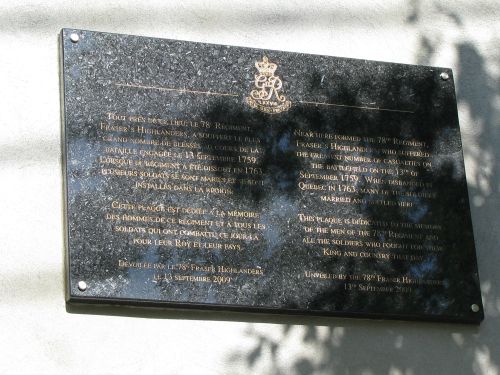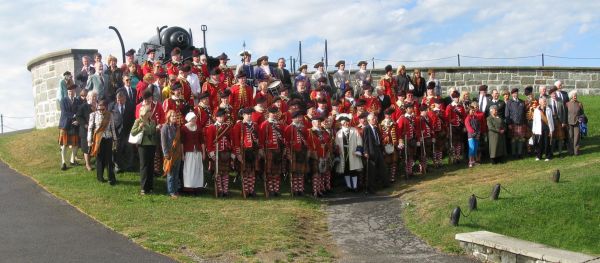Loyalist Participation in Events
78th Frasers Commemorate Battle of the Plains of Abraham in Quebec City
The weekend of September 11 to 13 found many officers and “miladies” of the recreated 78th Fraser Highlanders Regiment, from the regimental garrisons and outposts all across Canada and the U.S., gathered in Quebec City to commemorate the significant role played by the troops of the original 78th at the Battle of the Plains of Abraham two and a half centuries ago. The weekend was superbly organized by the St. Andrew’s Garrison of the Regiment, based in Quebec City, under the command of Major Guy Morisset, and with the active involvement of Brevet Major Erik Plourde and a group of dedicated Frasers, including the proud “squad” of young men in their Highland uniforms of Seven Years’ War vintage. The Fort St. Helen Garrison from Montreal was represented by its Officer Commanding, Major Bruce Bolton (also a Lt. Col. of the Black Watch Regiment), as well as by former Dominion President of the UELAC, Okill Stuart, U.E., and his wife Milady Sylvia, and Heritage Branch President, Robert Wilkins, U.E., and his wife, Milady Maura. Okill is a former Officer Commanding the Fort St. Helen Garrison and Robert is a Lieutenant.
The weekend began on Friday evening, September 11, with a lavish reception at Quebec City Hall, where Councillor Raymond Dion welcomed the Frasers to Quebec, on behalf of Mayor Régis Labeaume and the City Council. Mr. Dion was rewarded by being made an honorary member of the Regiment, with the consent of Col. Robert Darling of York Garrison, the Colonel Commandant of the Regiment, and the concurrence of the various command groups present. The visitors were then entertained to a delicious supper in the Kirk Hall of St. Andrew’s Church, whose first Presbyterian congregation in 1759 included veterans of the original 78th. The church building dates from 1810 and is a treasure of architecture in a city itself recognized by UNESCO as an architectural jewel. A presentation was then made by Ensign R. Paul Goodman describing recent and extremely detailed research on the British line at the Battle done, using a variety of images, memoirs and maps, by him and Captain Lieutenant Earl Chapman, historian of the Fort St. Helen Garrison (and husband of Heritage Branch Genealogist Joan Chapman, U.E.). This research questions some of the commonly held beliefs about the composition and structure of that famous “thin red line” on that fateful day. This research is soon to be published as a scholarly article. The evening ended with a film on the Battle, as recreated by the CBC in its highly acclaimed series “Canada: A People’ History”.
Saturday, September 12, saw the latter-day Frasers sailing the St. Lawrence River aboard the comfortable cruise ship LE COUDRIER. From Bassin Louise, the ship took the visitors down river to Ile d’Orléans, where General Wolfe’s headquarters was located during that fateful summer of 1759. Close at hand is the site of Wolfe’s failed July 31 attack on the Beauport flats, near Montmorency Falls. Under beautifully warm and sunny skies, and savouring delicious hors d’oeuvres served on deck by attractive hostesses, the Frasers made their way back upstream to the Bassin Brown, where Wolfe’s troops disembarked from their landing craft on the night of September 12 to 13, before climbing Anse au Foulon (now Gilmour Hill) to the Plains of Abraham above. A small squad of young Fraser lads re-enacted the landing in a rowboat.

Near here formed the 78th Regiment,
Fraser’s Highlanders, who suffered
the greatest number of casualties on
the battlefield on the 13th of
September 1759. When disbanded in
Quebec in 1763, many of the soldiers
married and settled here.
This plaque is dedicated to the memory
of the men of the 78th Regiment and
all the soldiers who fought for their
King and country that day.
Unveiled by the 78th Fraser Highlanders
13th September 2009
Later, three school buses drove the group on a fascinating tour of Quebec City. At St. Patrick’s School, near the exact place where the original Frasers lined up at the outset of the Battle, a plaque affixed to the wall of the School, the gift of the Regiment, was dedicated by the Reverend Canon Christopher B.J. Pratt, Rector of The Church of St. John the Evangelist in Kitchener, Ontario (and an officer with the Regiment’s Kitchener Garrison), honouring those gallant Fraser warriors. Then it was back to the Hotel Clarendon to freshen up and dress for a sumptuous dinner in the elegant surrounding of Quebec’s historic Garrison Club located inside the ramparts and near the St. Louis Gate.
Sunday, the 250th anniversary of the Battle, began early with a short commemorative service at the Citadel. A detachment from the recreated Compagnies Franches de la Marine (one of the French regiments that defended New France) joined the 78th Fraser “squad” and an exchange of swords was executed by the officers of each unit, as a symbol of mutual respect. Major Bolton, speaking in English and French, recalled the importance of remembering, in a non-political manner, those on both sides of the Battle, who did their duty that day in the service of their respective kings. Anglican, Roman Catholic and Presbyterian clergy were represented, as well as several Ursuline nuns. Sisters of their religious order famously knitted socks for the Fraser troops during the frigid winter of 1759-1760. Souvenir photos were taken from the heights of the Citadel’s battlements, after which all involved made their way once more to St. Andrew’s Church for a service conducted by Rev. Katherine A. Burgess, the present minister.

Group photo of the Frasers and Friends
Click here for a larger photo
The weekend went off without a hitch, free of any politically-inspired disruption by Quebec separatists. The men and women of the latter-day 78th Fraser Highlanders’ Regiment were royally received and cared for by the St. Andrew’s Garrison from start to finish. The civic officials and hotel staff were no less cordial. The timing and coordination of every activity were virtually flawless. Most importantly, the moving story of the brave men who fought and died (on both sides) on that momentous day two hundred and fifty years ago left an indelible mark etched in the memories of all who were privileged to participate in commemorating their heroism and their sacrifices. A special moment in Canadian history was thus fittingly observed.
by Robert Wilkins



